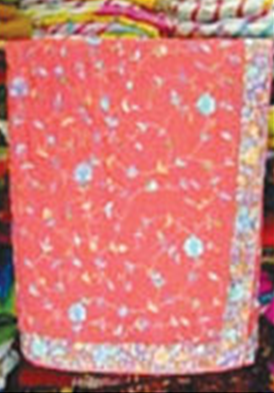Ghara embroidered fabric
This is a collection of articles archived for the excellence of their content. Readers will be able to edit existing articles and post new articles directly |
Ghara embroidered fabric
A treasured heirloom
By Faridah Hemani
The ghara embroidered fabric has its origin in 19th century China. Parsi traders brought it to India, where it gained immense popularity amongst the community
Whether you own one or not, the timeless elegance of a ghara sari is difficult to ignore.
Even an untrained eye can quickly recognise its beauty and intricacy which could easily take months to complete. Although it is almost next to impossible to purchase a genuine ghara sari nowadays, many enterprising designers are locally reproducing ghara inspired garments, lending this age-old tradition a contemporary touch.
The fabric has its origins in 19th century China where it was patronised by Parsi traders who brought it to India where it gained immense popularity amongst the community. Converted into a fully or partially embroidered sari or a sari with a ghara border, it was worn on special occasions such as weddings and navjote (coming of age celebration of Parsi boys and girls).
In India, this craft which is also believed to have some European influence, was adopted by local artisans who refined its original bulky state. Even today, it is considered a treasured heirloom, to be passed on from generation to generation.
Each ghara unfolds a vibrant story along its length. With as many as 20 to 30 colours in a single ghara piece, the finish is so neat that it is difficult to tell the right side of the embroidery from the back side. However, it’s the delicate motifs used in the embroidery that lend it a distinctive touch.
From houses, birds, bridges, leaves, flowers, trees to soldiers, river banks, shrines and Chinese pagodas, many pieces depict scenes from Chinese life, making the fabric almost similar to a colourful, mystical storybook. Ghara designs are also known by special names such as chakla/chakli for the male and female sparrow motif or the karolia or spider a flower motif.
Needless to say, depending on the number of different motifs used in a particular piece, the more intricate and closer together the motifs, the more expensive the ghara.
Drawing from a palette of vivid colours, the most popular background colours used in ghara embroidery still remain navy blue, red, black or white. Soft pastel colours are often combined with violet, wine red, and peacock blue in silk or cotton thread to create stitches such as French knots and other varieties which adorn these painstakingly created pieces.
It is believed that due to the complicated nature of these motifs, if an artisan specialised in a bird or a bridge motif, then he would stick to it for the rest of his life. Therefore, each piece would be the creation of a number of specialised artisans who would work on it for months at end. Often, to break the monotony, the artisans work on simple embroidery saris before resuming work on a ghara.
It goes to the credit of a number of local and Indian designers who are trying to revive this dying art in a stylish manner in modern western attire, introducing it to the younger generation.
Since original ghara or ghara inspired garments are grand, it is best they are not overpowered with heavy jewellery, accessories or make up. It is better to stick to simple jewellery or just pearls to accentuate this classic art form.
